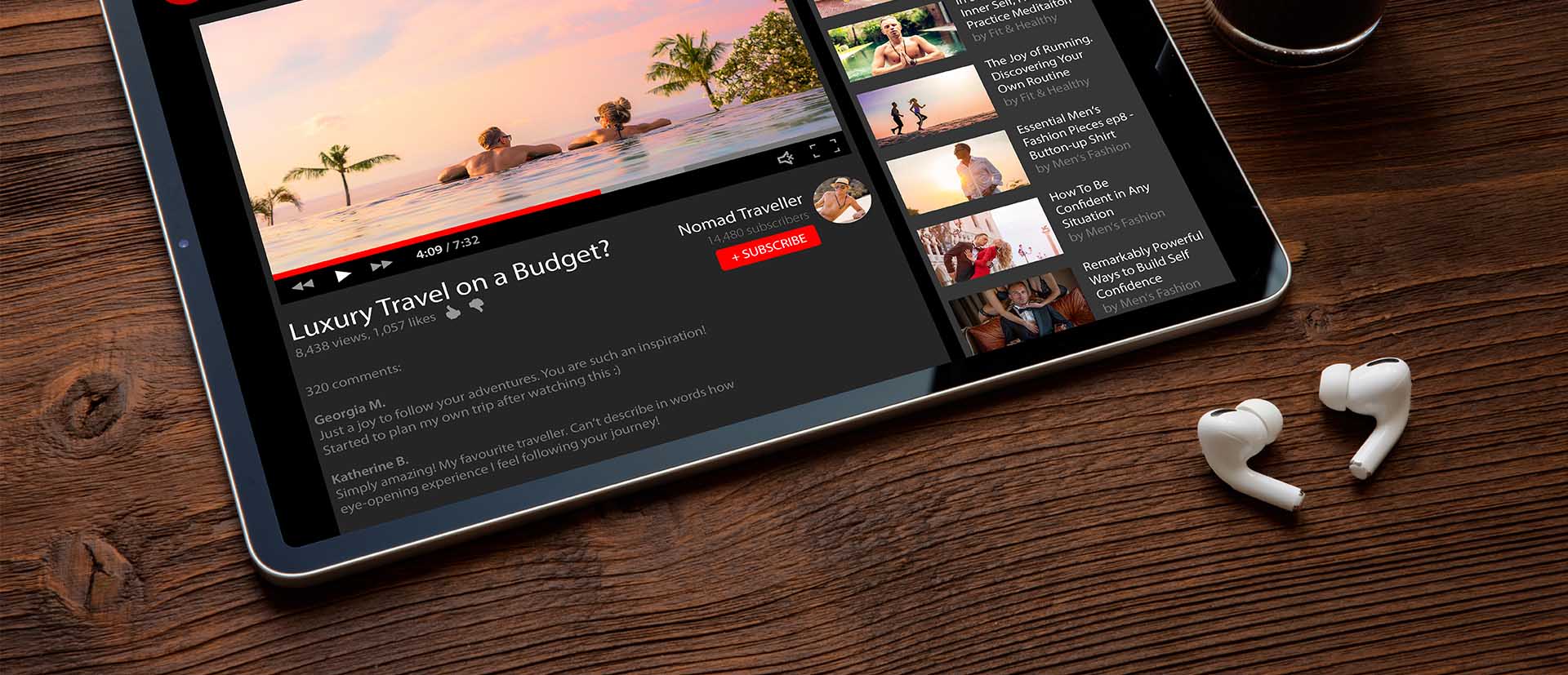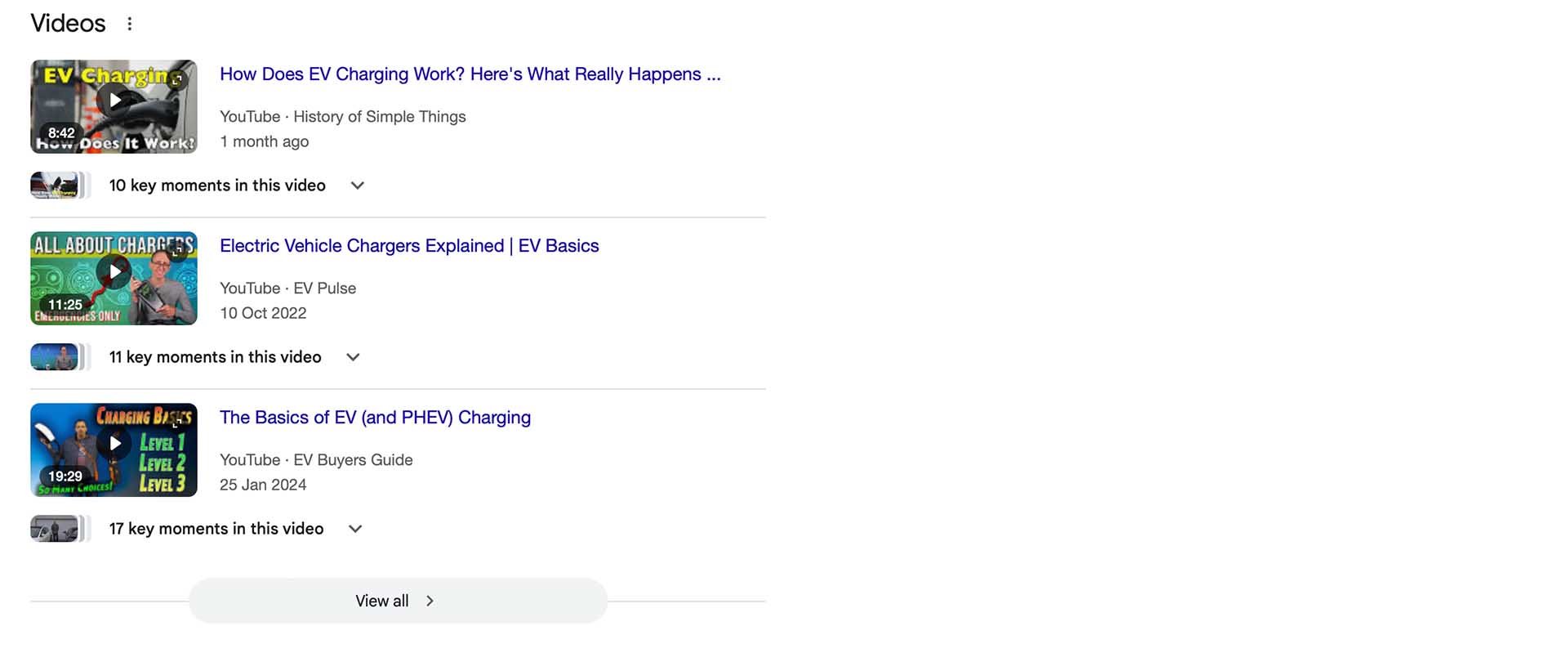
Video SEO 2025: How to Optimise Your Video Content for Search
Intro
For the last, what… 25 years? We’ve been taught that the holy grail of online visibility is landing on Page 1 of Google. Sure, social media came along and gave businesses a new avenue, but let’s face it, Google remains the main gateway to the internet for most people and the biggest driver of traffic for most businesses.
The problem? Ranking on Google is tough. With constantly shifting algorithms and fierce competition, climbing the rankings can feel like a losing game.
But here’s the thing: we’re not an SEO agency, corporate video production is our thing. And it just so happens that video content can be one of the most effective (and underused) shortcuts to visibility on Google.
Unless you’ve been avoiding the internet entirely, you’ll have noticed that a typical Google results page has changed dramatically.
As Justin Aldridge, Technical Director at Artemis Marketing, puts it:
“Google is no longer just a list of blue links. The search results page now offers multiple entry points; sponsored, local pack, AI overviews, shopping, and increasingly, video. If your goal is visibility and clicks, creativity in how you rank can often outperform the traditional battle for top 10 text results.”
And that’s where video comes in. A well-optimised video can land you in Google’s dedicated video section, often around position 3, giving you prime visibility without needing to win the long, slow race to the top of the text results.
As we’re damn fine people, we’ve written this guide on how to use video SEO to your advantage. From strategy to structure, metadata to promotion, we’ll show you how to help your videos get seen, clicked, and ranked, right where your audience is already searching.
Do Your Keyword Research First
Video SEO isn’t just traditional SEO with a play button, it needs its own approach, especially when it comes to keywords. Take our EV charger manufacturer, for example. Sure, “Best EV Charger” might sound like the obvious keyword to chase. But search it on Google, and you’ll notice something: no videos. That’s because Google doesn’t see that query as having video intent, it’s looking for reviews, listed products, and comparison charts.
That’s where intent comes in (don’t worry, we cover this properly later). For now, know that queries with strong video intent often start with “how,” “what,” “why,” or “should I.” And you don’t need fancy tools to find them, just start typing into Google or YouTube and let autofill do the work. Those suggestions are real-time clues to what your audience is actively searching for, and the perfect starting point for choosing a video topic that’s actually going to rank.
Of course, if you want to go deeper, tools like Semrush, Ahrefs or AlsoAsked can show you exact volumes, trends and gaps. The goal is simple: find out what people want to watch before you invest time making it. Otherwise, you risk making the world’s best video on a topic no one’s Googling.
Choose the Right Hosting Platform
We’d love to say there’s a fair fight out there between video platforms, but let’s be honest, Google’s playing favourites. And that favourite is YouTube. If your goal is to appear in Google’s search results, especially in the video section, then having a well-maintained YouTube channel isn’t optional, it’s essential.
That doesn’t mean you can’t host your videos elsewhere too. In fact, a hybrid approach works well: use YouTube to feed the algorithm and reach new audiences, but keep a self-hosted version on your site for better branding, conversions, and analytics control. Just don’t rely on private hosting alone if ranking on Google is the aim. When it comes to video SEO in 2025, YouTube is still the golden ticket.

Video Intent
It sounds obvious, but too many brands make videos they want to create, not what people are actually looking for. The key to video SEO is focusing on topics with clear video intent, questions or queries where people expect a visual answer. Think explainer videos; how-tos, tutorials, demos, comparisons, anything that’s better shown than told.
Back to our EV charger example, one standout autofill result is “How to install an EV charger at home.” That’s your cue. Instead of trying to force a video into a keyword that doesn’t suit the format, lean into what people are already looking for, then answer it, clearly and visually.
To summarise, Matt Bertram from EWR Digital – experts in Generative Engine Optimization (GEO) says
“When your title is written for clarity, your hook is fast, and your answer is focused; the more directly you meet the viewer’s need, and the more likely it is that the platform surfaces your content.”

Optimise Your Video Title and Description
Your video’s title and description aren’t just admin, they’re prime real estate for video SEO. Google (and YouTube) rely on them to figure out what your content’s about, so it’s worth taking the time to get them right. That means doing a bit of keyword research to see what your audience is actually searching for, and then weaving those terms in naturally and regularly.
But don’t just write for the algorithm. A great title should also make a real person want to click. Think of it as part headline, part teaser. Something like “How to Install an EV Charger at Home (Step-by-Step Guide)” is far more clickable, and searchable, than something vague like “EV Charger Video”. Be specific, relevant, and crystal clear about what the viewer’s going to get. If your title answers a question or solves a problem right away, you’re already ahead.
Always Include a Transcript
Adding a transcript isn’t just a nice accessibility move, it’s a video SEO win-win. It gives search engines something to crawl (since they can’t “watch” your video), and it helps your content show up for long-tail, conversational queries, especially in this AI-driven search era.
If you’re covering a complex topic, like tech, science, or anything jargon-heavy, a transcript helps reinforce your authority and make your message clearer. Plus, it makes your video more useful to viewers who prefer to skim or read. It’s a small step with a big impact on both ranking and user experience.
Optimise Your Thumbnail
Think of your thumbnail as your video’s front cover, it’s the first thing people see, and it heavily influences whether they click. A well-designed thumbnail can make the difference between getting watched or getting ignored.
Custom thumbnails with human faces tend to perform best (some studies say up to 154% better), especially when they clearly hint at the video’s value. So don’t just grab a random frame, design it with purpose. Make it eye-catching, relevant, and a little bit scroll-stopping. After all, if your title is the hook, your thumbnail is the handshake. And don’t forget about size, thumbnails appear small in search results, so clarity is everything. Avoid cramming in too much text or visual noise. Keep it bold, clean, and instantly recognisable at a glance.

Use Timestamps and Chapters
Timestamps aren’t just for the neat freaks among us, they’re a powerful tool for video SEO. Especially on YouTube, chapters help your video surface for a wider range of search queries by breaking down the content into bite-sized, searchable sections.
They also make your video more user-friendly, letting viewers jump straight to what they need. And with AI-generated summaries and featured snippets on the rise, clearly labelled chapters give your video a better shot at being pulled into those results. It’s a small effort that pays off in both rankings and watch time.
Promote Beyond Search
Video SEO doesn’t end with hitting “publish”, in fact, that’s just the beginning. Google takes notice of how people engage with your video across the web, so the more eyes you can get on it, the better your chances of climbing the ranks.
Share it across your social channels, drop it into your email campaigns, embed it in blog posts, and even consider a little paid promotion if it’s a key piece. The goal is to build momentum. Search engines love signals, and the more your video is watched, clicked, and shared elsewhere, the more likely it is to show up where it matters.
Don’t Forget Backlinks
Backlinks still matter, a lot. Even for video. If you can build keyword-rich backlinks pointing to your YouTube video, you’re sending strong authority signals to Google.
Think of it like giving your video a reputation boost. Whether it’s from blog articles, partner websites, online PR, or embedded placements, every relevant link helps. So if your video’s worth watching, it’s worth linking to, just like any other piece of valuable content.
And, finally…
Video SEO in 2025 isn’t about gaming the system, it’s about understanding how people search, what they want to see, and giving it to them in a format that Google actually wants to rank. That means creating genuinely useful content, optimising it properly, and being smart about where and how it lives online. It’s not always easy, but it’s absolutely worth the effort. Done right, video doesn’t just boost visibility, it earns clicks, builds trust, and drives action. So whether you’re a marketer, business owner, or content lead, treat your videos like the powerful search assets they are. For further information on making your videos work for you, check out our post on video marketing statistics and follow our tips for even greater video exposure.



